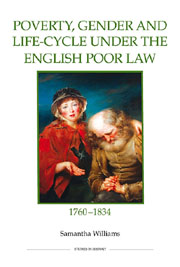Book contents
- Frontmatter
- Contents
- List of figures
- List of tables
- Dedication
- Acknowledgements
- Abbreviations
- Map 1 Bedfordshire, c.1834
- Introduction
- 1 People, place and poverty
- 2 Policy and paupers
- 3 Paying for poverty
- 4 Gender, life-cycle and the life-course
- 5 Work, unemployment and the makeshift economy
- Conclusion
- Bibliography
- Index
1 - People, place and poverty
Published online by Cambridge University Press: 05 February 2013
- Frontmatter
- Contents
- List of figures
- List of tables
- Dedication
- Acknowledgements
- Abbreviations
- Map 1 Bedfordshire, c.1834
- Introduction
- 1 People, place and poverty
- 2 Policy and paupers
- 3 Paying for poverty
- 4 Gender, life-cycle and the life-course
- 5 Work, unemployment and the makeshift economy
- Conclusion
- Bibliography
- Index
Summary
Bedfordshire is a highly appropriate county to study in the context of the crisis of the old poor law: it was one of the counties in which both contemporaries and historians believe parish allowances to have been widespread. The county was labelled by the 1824 Select committee on labourers' wages as one of the six most addicted to the allowance system and is one of Mark Blaug's hard core of ‘Speenhamland counties’. The Poor law report of 1834 cited Bedfordshire, along with Berkshire, Buckinghamshire, Cambridgeshire, Cheshire, Cornwall and Cumberland, as typical of the country as a whole: ‘we believe, in short, that a fairer average of the whole country cannot be taken.’ That the poverty problem was primarily concentrated in the south and east is reflected in the proportions of county populations on relief in 1831: in Berkshire the figure was 17 per cent; wiltshire 15 per cent, Essex and Sussex 14 per cent; Dorsetshire and Oxfordshire 13 per cent; Buckinghamshire, Huntingdonshire and Suffolk all over 12 per cent; Cambridgeshire, Kent, Hertfordshire, Norfolk and Northamptonshire 11 per cent or more; and Herefordshire, Leicestershire, Bedfordshire, Shropshire and Hampshire 10 per cent or more.
The economic and social profile of Bedfordshire had a direct impact upon the level and experience of poverty by its inhabitants. Although the county was predominantly agricultural, its economy also rested heavily upon cottage industry. Large numbers of women and children were occupied in spinning, pillow lace-making, straw-plaiting and hat manufacture.
- Type
- Chapter
- Information
- Publisher: Boydell & BrewerPrint publication year: 2011



